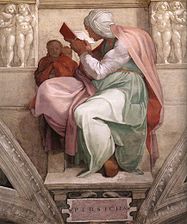Sibyl
The sibyl is a character from Greek and Roman mythology. She is a prophetess, sometimes inspired by Apollo, capable of knowing the future.
The most important of all in Roman mythology was the Cuman sibyl. Other traditions affirm that her father was Zeus, the result of her relationship with a daughter of Poseidon called Lamia, so her gift is of divine origin. There are also traditions citing Herophile as the daughter of Zeus.
The sibyls lived in caves or near streams. The prophecies were always expressed in a trance state and expressed in Greek hexameters that were transmitted in writing.
History and evolution
The Spanish term Sibila, is a calque of the Latin: Sybilla, derived in turn from the Greek: Σῐ́βυλλᾰ (Sibylla) This etymology, accepted by Lactantius, has been questioned from the XIX century, proposing Semitic or Italic etymologies.
Grimal, in his Dictionary of Greek and Roman Mythology, says that according to some traditions, Sibylla was the name of the daughter of the Trojan Dardanus with a woman named Neso, daughter of Teucer, who was endowed with the gift of prophecy. From her this name was given to all women capable of prophesying.
The myth of the sibyl was born in Asia Minor and from there it passed to Greece and then to Rome. The Fathers of the Church, in Christianity, adopted the sibyls of classical Antiquity giving them the role of prophetesses just like the biblical prophets. The Christians were warned of the existence of these sibyls who had mysteriously announced the arrival of the Savior.
Iconography in art
Christian iconography through art represented the sibyls throughout the Middle Ages and during the following centuries, being the great apogee in the Renaissance. In the Middle Ages they were represented as symbolism of the messianism of Jesus. In the 13th century the Eritrean sibyl appears in the Dies Irae of Thomas of Celano announcing the end of the world.
|
In the 15th century it is sometimes confused with the Annunciation.
It is also common to see the sibyls in a group, mixed with the prophets or paired with ancient philosophers, as can be seen in a manuscript by Raban Maur (xi century which is located in the Monastery of Montecassino. In the Renaissance period, representations of sibyls are abundant.Great painters such as Raphael (Church of Santa Maria de la Pace in Rome) and Michelangelo (Vault of the Sistine Chapel of the Vatican) demonstrated this in their works. Michelangelo painted in this vault, interspersed with five prophets, the five most representative sibyls in his time, which are:
- Sibila eritrea
- Sibila pérsica
- Sibila líbica
- Sibila cumana
- Sibila delfica
- Sibilas in art
Ten sibyls described by Marcus Terence Varro
Early Greek writers only speak of a sibyl. It is believed that they refer to the sibyl called Herophile, who prophesied the Trojan War.Others arose later, always with the name of her origin. A list made by Varro collected in a work by Lactantius, reaches ten:
- Sibila de Samos
- Sibila eritrea
- Sibila del Helesponto
- Sibila frigia
- Sibila cimeria
- Sibila delfica
- Sibila de Cumas
- Sibila libia
- Sibila tiburtina
- Babylonian or Persian Sibila
Heraclitus (5th century BC) is the first Greek author to whom we have references who speaks of the sibyl and he only mentions one. Likewise Plato speaks of only one sibyl. Over time the number increases to three, ten and even twelve. In all cases, rather than by name, which they did not own, they were known by the name of the place where they lived.
Sibyls in Spanish literature
The playwright Pedro Calderón de la Barca wrote two plays that had the Sibyl as the central protagonist. These are the comedy La sibila del Oriente and the auto sacramental El árbol del mejor fruto, both texts being two theatrical versions of the same theme with much of the text in common. The central plot revolves around the construction of the mythical Temple of Solomon. A visionary Queen of Sheba visualizes a magical tree, a mixture of cypress, palm and cedar, born from the seeds of the Tree of the Knowledge of Good and Evil, which will be the one to be used for the construction of the temple, but also that in it will be crucified Jesus Christ.
Contenido relacionado
Pallas
Baal
Tlaloque






